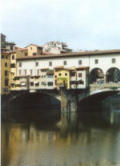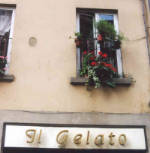|

The Italian way of life radiates the feeling of
relaxation, simplicity and enjoyment, and like other uptight Americans, I
was eager to discover Italian secrets to the high life. Each time I
visit Italy I am immediately overwhelmed with smells, tastes, sights and
sounds that make Italian lives so vibrant. On this trip to Italy, I
planned to turn up the intensity of my senses and to delve head-first into
Italian culture.
I started strolling through
the antique streets of Florence, an idyllic setting for promenades, and
noticed all of the shops, churches, piazzas, mimes, vespas and art that
are the spirit of Florence. Several times I had to dodge out of the
way of an impending vespa, topped with an Italian who seemed to take no
notice or care of the hundreds of pedestrians that lined the
streets. Dogs trotted in and out of alleyways and leered dangerously
close to my feet and the wheels of the vehicles. Mimes, painted head
to toe in ghastly white, silver or gold, stood motionless atop blocks of
wood and made the occasional twitch or nod that left tourists
mesmerized. I heard bits of conversations in Italian, English,
French, German and others I was unable to decode. Amongst all this
diversity, I noticed one common link that seemed to bring a smile to
anyone’s face--the cone or cup of gelato they held in their
hands. Of all colors of the rainbow, and dripping everywhere onto
shirts, hands or chins, Italy’s version of ice cream seemed to be the
biggest tourist attraction, next to the Duomo.
 Having worked at two
prominent ice cream shops at home in Denver, and knowing quite a lot about
ice cream and its place in American culture, I became very curious about
gelato and its prominence in Italian culture. The more I learned
about it, the more I found that gelato is a considerable component to the
simplicity and beauty of Italy.
Having worked at two
prominent ice cream shops at home in Denver, and knowing quite a lot about
ice cream and its place in American culture, I became very curious about
gelato and its prominence in Italian culture. The more I learned
about it, the more I found that gelato is a considerable component to the
simplicity and beauty of Italy.
My parents went on a
mission to cell phone shops, internet accessible places and churches, and
I set out to find as many gelaterias as I could and see what this whole
gelato craze was about. Not surprisingly, on every crowded street I
found two to three gelaterias, but the most intriguing were those
out-of-the-way shops snuggled into a narrow cobblestone passageway.
At the end of my day, I tallied up about thirty gelaterias I’d found in
Florence, whereas Denver has only six major ice cream stores. With
the considerable tourist crowd that Florence draws, these little shops
have no trouble staying prosperous, and oftentimes have lines weaving out
their doors.
 The word "gelato"
is the Italian past participle of the verb "gelare", meaning
"to freeze". There are several kinds of frozen delicacies
in Italy, each with a slight variation of ingredients and frozen
temperature. Gelato, though not as frozen (and thus softer than) ice
cream, is still Italy’s richest and most dense frozen dessert. It
is usually milk-based with real fruits, chocolates or other fresh flavors
whipped into it. "Semi-freddo" is a term for a softer,
smoother, creamier form of gelato, frozen at a slightly warmer
temperature. Sorbetti, like sorbet in the United States, has no milk
products, yet is frozen like gelato and thus able to be free-standing on a
cone. Granite, on the other hand, is much like a "slushie",
as it is pure tiny ice shards flavored brilliantly with fresh fruit and is
eaten from a cup.
The word "gelato"
is the Italian past participle of the verb "gelare", meaning
"to freeze". There are several kinds of frozen delicacies
in Italy, each with a slight variation of ingredients and frozen
temperature. Gelato, though not as frozen (and thus softer than) ice
cream, is still Italy’s richest and most dense frozen dessert. It
is usually milk-based with real fruits, chocolates or other fresh flavors
whipped into it. "Semi-freddo" is a term for a softer,
smoother, creamier form of gelato, frozen at a slightly warmer
temperature. Sorbetti, like sorbet in the United States, has no milk
products, yet is frozen like gelato and thus able to be free-standing on a
cone. Granite, on the other hand, is much like a "slushie",
as it is pure tiny ice shards flavored brilliantly with fresh fruit and is
eaten from a cup.
|



